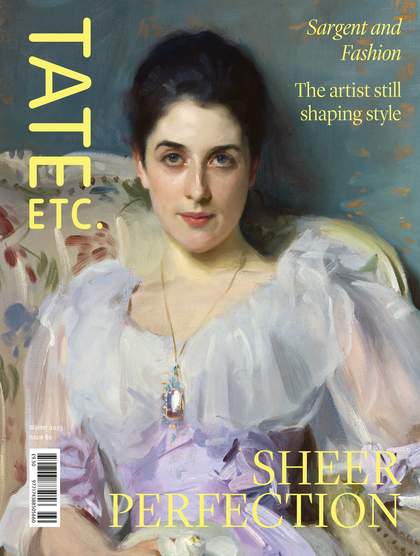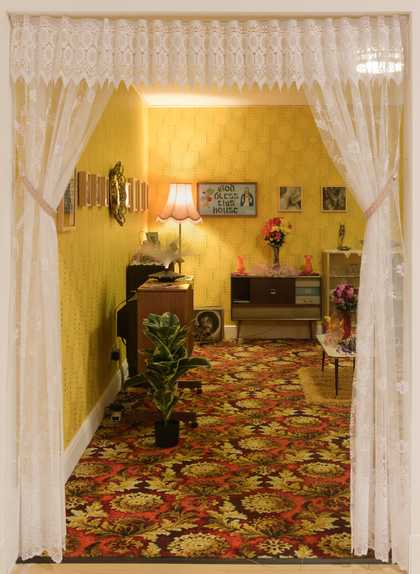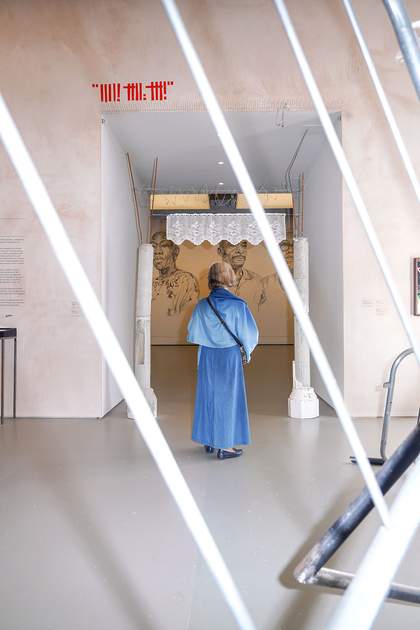
Photo © Guy Bolongaro / SevenSix
In the week I was due to write this feature, my ongoing health issues hit a wall, and the world outside seemed to be crumbling. Confined to bed and feeling hopeless, I couldn’t help but query what good art could really do in a moment of crisis. But this question – of the role art plays in society – always rears its head around the Turner Prize. Now in its 39th year, the prize is one of the most visible events in the UK art calendar and attracts both crowds and column inches, with nominees held up as supposed markers of contemporary creativity. In 2023, Jesse Darling, Rory Pilgrim, Barbara Walker and Ghislaine Leung face the same scrutiny. With a breadth of practices that can’t easily be compared, what they collectively reveal is the many routes and avenues art can offer to us.
I visited Towner Eastbourne gallery on a Friday evening in October. Entering an exhibition space as a disabled person is often a frustrating experience; galleries are rarely designed with us in mind. So, it was refreshing to find that, here, accessibility takes centre stage. There are wheelchairs and portable stools, a lift wide enough to accommodate multiple mobility aids, a sensory bag complete with stim toys, ear defenders and a sunflower lanyard. There are large text guides, subtitles, quiet showings, gender neutral toilets and benches with back supports. The invigilators are helpful and engaged. For this edition of the prize, Towner also collaborated with autistic artist Anna Farley in the designing of five separate visual guides: one for each exhibiting artist and one to welcome people to the space. Informed by her own experiences as well as those of her peers with additional needs, Farley notes that the gallery’s offer is ‘revolutionary... what tends to benefit one community has the potential to benefit all communities.’ Certainly, I’ve never moved with such ease around a gallery.
Access is embodied within the artworks too. Rory Pilgrim astutely attends to those who feel isolated and cut off from society, while Barbara Walker’s arresting portraits of those impacted by the Windrush scandal highlight the disabling barriers around race and migration. Jesse Darling manipulates familiar objects, including physical barriers, in a space nevertheless designed to ensure a wheelchair can move freely through it. Leung’s scores – written descriptions of how a particular work should be displayed – provide a resonant interpretation of visual language. At Towner Eastbourne, a shift is palpable – a consideration not only of how art can be accessed, but also who the art is for.
Jesse Darling
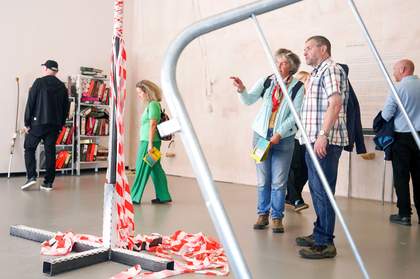
Photo © Guy Bolongaro / SevenSix
To walk into the world of Jesse Darling is to come upon Britain under the microscope, with everything slightly askew. At Towner, he has created a confronting space. Visitors are funnelled down a pathway lined with steel barriers, which opens out on to a room filled with objects both familiar and strange. Ceramic hands extending from the walls clutch doilies and sledgehammers. Stacks of coloured lever-arch files tilt precariously towards you. Crutches form the feet of a phallic structure. The barriers themselves sprout legs and walk up the walls.
Darling takes an interest in crowd control devices prevalent within Britain’s vernacular architecture, guarding ‘the queue, the festival and the busted playground,’ he tells me. Simultaneously, the barriers carry a symbolic acknowledgment of the UK border. For the exhibition, Darling took cues from Towner’s coastal location, and the sobering proximity of the channel which ‘people die trying to cross’.
Darling has often been cited as subverting the objects used in his installations, fixating on their meanings and contradictions – moving barriers, pliable tracks, polystyrene pillars. As with Britain itself, which as Darling has said, can be absurd but ‘also vaguely sinister’, he reads the upholding of rigid and often arbitrary rules as ‘ridiculous and funny, but in some ways no joke.’ The barriers’ title, Come On England, came to Darling in a dream, and plays with the sense of cartoonish patriotism, set against the backdrop of disillusionment with a country that’s falling apart. What we are left with is an amalgamation of objects not living up to their designated function.
Conscious of how the viewer might move around the space, including designing his installation to allow the free movement of a wheelchair, Darling knew it should feel chaotic. Darling tells me he ‘wanted it to feel in the body’, as if the barriers ‘were forcing you in’ so that you would ‘really feel that there were barriers inside of you.’ Everything feels slightly off, with the walls painted a ‘kind of dingy pink... I want your body to know you’re not in a white room’. An ode to the faded glory of seaside towns, the colour lulls the audience into a false sense of security, even as something feels not quite right.
As they move through the space, the visitor’s eye lingers on a maypole, fashioned from hazard tape. Darling showed me a video of his collaborators dancing around the maypole to construct it. It provided a glimpse into the joy and amusement Darling takes in making art and observing the world around him. ‘I wanted to show how complicated and connected things are, how wonderful and how terrible they are. And how all that hangs together somehow.’
Rory Pilgrim
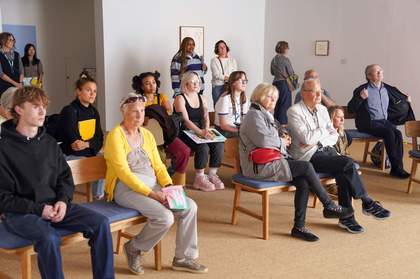
Photo © Guy Bolongaro / SevenSix
Rory Pilgrim's film Rafts grew out of the Covid-19 pandemic. Developed with eight collaborators from Green Shoes Arts, a community group working with disadvantaged and vulnerable young people and adults in Barking and Dagenham, the work began in the winter of 2019, and ended up spanning two and a half years.
Taking the outlines of songs as a starting point, Pilgrim worked with members of the East London community group to create a film of connected musical performances, each telling a specific and deeply personal story. Using music, poetry, dance, movement and dialogue, the contributors muse on the meaning of the ‘raft’, expressed by Pilgrim as ‘a most fragile form of transport in times of escape’ and a symbol that felt ‘so clear and visceral, especially with where we’re at now in the world.’
In brief interludes throughout the film, we follow the journey of a small raft in a moving animation by Catherina Rowland, and also view a joyful response in dance by Barking and Dagenham Youth Dance group. The film’s message is reflected by a series of artworks: delicate drawings made from pencil, crayon and nail polish by Pilgrim; miniature sculptures, wood carvings, handwritten letters, and thumbnail paintings by contributors.
The idea of creativity as a lifeline or alternative form of therapy recurs in RAFTS. Pilgrim’s collaborators muse about being out of work, recovery, and the healing possibility of creating. After a period of personal isolation and bad mental health, I felt held by the stories within the film. The recognition of the many people going through similar struggles was one of the project’s central pillars. As Pilgrim reflects: ‘I think one of the most precious things we can do is also think about dreaming or the imagination as a support structure. It is something that is so rudimental to our existence.’
It is rare to see gallery visitors sit and take in a film work in its entirety – but the room stilled to an awed quiet, with people visibly moved. This is an artwork that generatively offers a platform for many people, many artists, many stories. ‘I just hope I can create a space where people feel free to speak and also to be heard,’ Pilgrim said. ‘To listen and learn and think how that combines. And to create a practice in which there is not just my own voice, but the voice of many.’
Barbara Walker
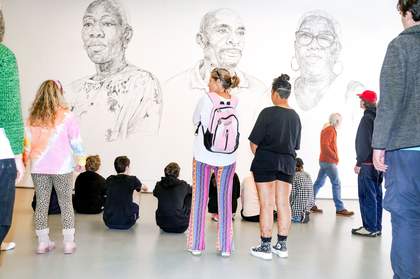
Photo © Guy Bolongaro / SevenSix
In order to properly comprehend Barbara Walker’s towering hand-drawn portraits, you have to come into their presence. Four giant figures rendered in pencil on the walls of the gallery look down on you as you enter. Rather than being imposing in their scale, the portraits feel as if they might be family members, friends or neighbours. Imbuing them with an intentional visibility, Walker attends to the lives of people directly impacted by the Windrush scandal of 2017, in which many Caribbean migrants who had long contributed to and made up the fabric of the UK were discovered to have been denied lawful immigration status, and faced deportation.
‘I was quite angry and upset. And I immediately thought of my mother and my father,’ says Walker. ‘Would they be subjected to this? And to think that these citizens contributed to – were invited to – Britain to help support the country after the Second World War, and then to be categorised as illegal immigrants; it’s heart-wrenching.’
To witness Walker at work is to see an artist comfortable in the interiority of solitary creation. Using a platform lift and a long wooden rod, there is a deep physicality to how Walker manifests the drawings. ‘When I’m working it’s like the air I breathe, it’s like life itself.’ In their scale, the portraits are reminiscent of the presidential heads of Mount Rushmore. Here, Walker questions who is, and who isn’t, memorialised.
Many of the people represented in Burden of Proof expressed a hesitancy with being involved in the project, as Walker explained: ‘A lot of them were tired, ground down; they’re waiting for the results of an application, the shame. We are often told not to share our private business in public. That’s another erasure... a quiet erasure happening behind the scenes.’ She simultaneously found a commonality of needing to gather documents: ‘These mundane, forgotten, ephemeral pieces of paper have now become the oppressive instruments to prove their legitimacy.’ The documents are the backdrops for the pencil portraits, with subjects almost blending into the ephemera that has become the key to their domestic status and livelihoods.
The large-scale portraits are never intended to be permanent, and will instead be washed away by Walker at the end of each iteration, further drawing attention to the erasure of Black lives in Britain. ‘I’ve always been erasing my work. Consciously or subconsciously. It’s one of the key signatures to my practice. In a way I’m already saying goodbye when I make the first mark.’
Ghislaine Leung
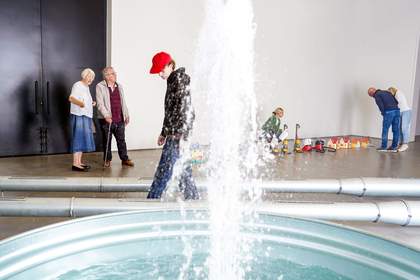
Photo © Guy Bolongaro / SevenSix
Nominated for her exhibition Fountains at Simian in Copenhagen, Ghislaine Leung creates artworks that explore questions of creativity, interpretation and labour. Objects including a ventilation system, surveillance monitor and fountain are repurposed and situated within the gallery space, where they take on new meanings. Institutions – both public and private – are interrogated and brought into clear view. In Public Sculpture 2018 a number of plastic children’s toys are displayed in a uniform line along the floor. Miniature models of houses, hoovers and washing machines draw attention to the institution of the home, in which gender roles are designated from an early age.
Leung’s work, like Pilgrim’s, is informed by music, and the relationship between composition and performance; it considers at what point notation becomes a piece of music. Is it when the composer writes a score, or when that music is read, interpreted and played? Based on her concept of ‘scores’, Leung writes simple, descriptive, instructional texts which are then used by the gallery team to install the works. Her scores, Leung says, come out of ‘very distinct grammars’ in which she writes and rewrites the text ‘multiple times over’ before settling on the final iteration. ‘Sometimes I’ll publish it and then it’s still not right. And I’ll only learn that in the second or third instance of the work being shown.’
Leung’s instructional texts were a solution to the challenges of being present when her work was installed: ‘I found it difficult to be present for install, to travel for shows, and residencies, mostly unpaid, while maintaining multiple jobs. It wasn’t sustainable, and politically not something I wanted to advocate for.’ This became even more important when she became a parent at the start of the pandemic, ‘when travel was impossible, and I had childcare commitments that far exceeded standard employment hours.’
Leung’s scores are an attempt ‘to forge another way to work as an artist’, one that ‘could be maintained in the longer term.’ The result makes us consider the many roles and facets that encompass artistic production, far beyond the artist’s initial gestures. ‘I’m interested in acknowledging the necessary co-creativity of everything. That everything is made with other people. That we are always holding and being held.’
Turner Prize 2023, until 14 April 2024. Curated by Noelle Collins, Exhibition Curator, Towner Eastbourne. Supported by King & McGaw, the University of Sussex and East Sussex County Council, with additional support from Lorna Gradden, Chalk Cliff Trust, The John Browne Charitable Trust and The Uggla Family Foundation.
Jamila Prowse is an artist and writer, aiming to develop dialogues and structures around ancestry, healing, disability and grief.

